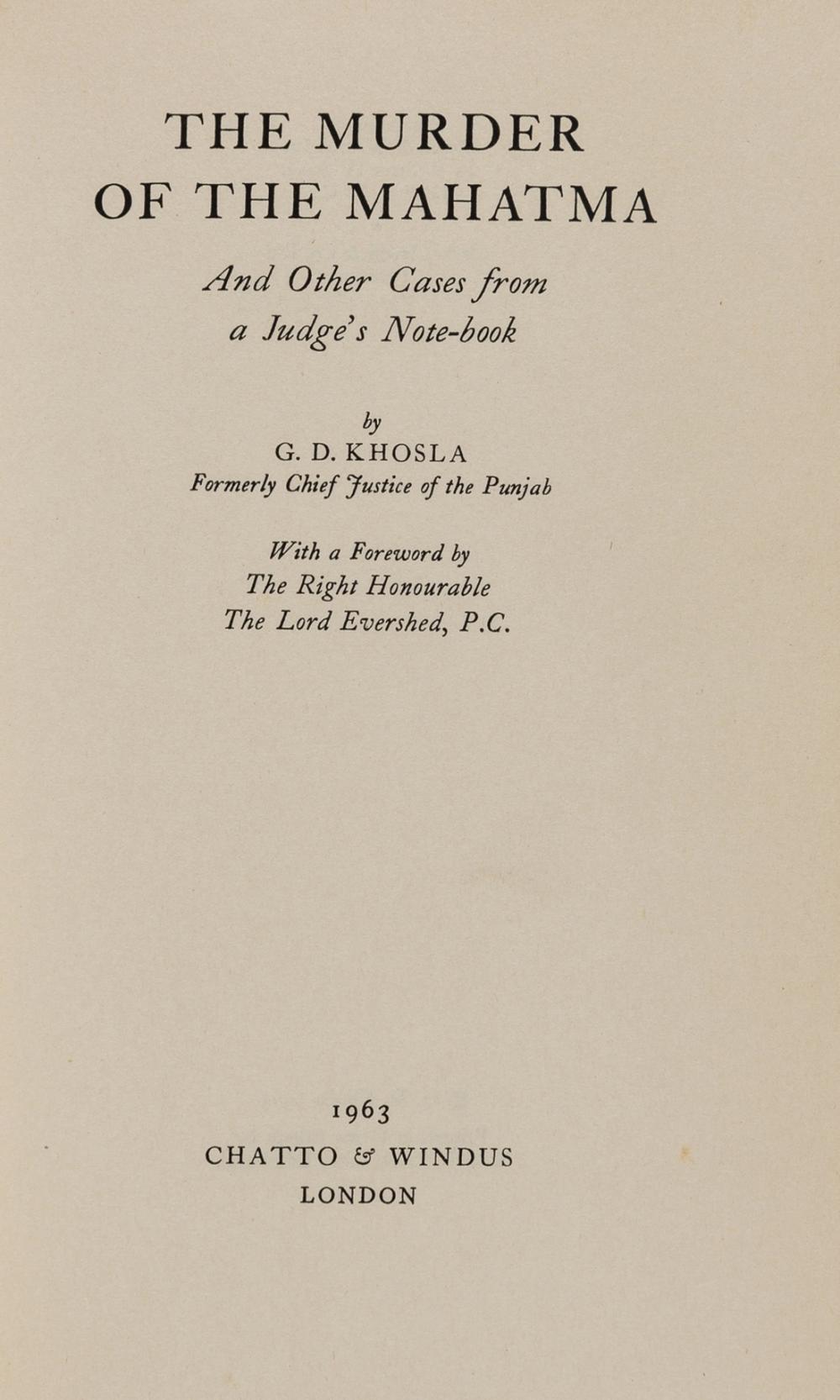The Murder of The Mahatma

About
Summary
Exquisite
TOC
Details
Related
URL
Images
Overview
The Murder of the Mahatma and Other Cases From a Judge's Notebook by G.D. Khosla, published in 1963, delves into the assassination of Mohandas Karamchand Gandhi, the preeminent leader of India's independence movement. Khosla, a judge, provides a detailed account of the events leading up to Gandhi's death, the assassination itself, the investigation, the trial of Nathuram Godse and his accomplices, and the aftermath. The book examines the motives behind the murder, the ideologies that fueled the conspiracy, and the impact of Gandhi's death on India and the world.
he Murder of the Mahatma chronicles the events surrounding the assassination of Mahatma Gandhi on January 30, 1948. Nathuram Godse, a Hindu nationalist, shot Gandhi in New Delhi. Godse believed that Gandhi was too conciliatory toward India's Muslim minority and held him responsible for the partition of India. The book meticulously recounts the planning and execution of the assassination, the capture and trial of Godse and his co-conspirators, and the legal proceedings that followed. Khosla examines the evidence presented during the trial, the testimonies of witnesses, and the arguments made by the prosecution and defense. The book also delves into the backgrounds and motivations of the individuals involved in the conspiracy, shedding light on the ideological forces that drove them to commit such a heinous act.
Importance of Book
Historical Record: The Murder of the Mahatma provides a detailed historical record of one of the most significant events in India's history.
Understanding the Motives Behind the Assassination: The book offers insights into the motives and ideologies that drove Nathuram Godse and his co-conspirators to assassinate Mahatma Gandhi.
Examination of the Indian Political Landscape: The book examines the complex political landscape of post-independence India, shedding light on the challenges and conflicts that shaped the nation's early years.
Reflection on Gandhi's Legacy: The book provides a valuable reflection on Gandhi's legacy as a leader, a philosopher, and a symbol of peace and nonviolence.
Insight into the Indian Legal System: As it details the trial, the book offers insight into the workings of the Indian legal system in the years immediately following independence.
Key Themes
The Assassination as a Political Act: The book examines Gandhi's murder as a political act rooted in ideological differences and conflicting visions for India's future.
Hindu Nationalism: The book explores the rise of Hindu nationalism and its role in shaping the events leading up to the assassination. Godse was associated with the Rashtriya Swayamsevak Sangh (RSS) and the Hindu Mahasabha, right-wing Hindu organizations that espoused a Hindu nationalist ideology.
The Ideological Divide: The book highlights the ideological divide between Gandhi, who advocated for Hindu-Muslim unity and nonviolence, and the Hindu nationalists, who sought to establish a Hindu-dominated India.
The Trial and Justice: The book focuses on the legal proceedings following the assassination, examining the trial of Godse and his accomplices and the pursuit of justice for Gandhi's murder.
The Legacy of Gandhi: The book reflects on Gandhi's legacy as a leader, a philosopher, and a symbol of peace and nonviolence. Gandhi's assassination served as a stark reminder of the challenges facing India in the aftermath of independence, including communal violence, political extremism, and the need for reconciliation and unity.
Cultural Significance
Reflection on Indian Identity: Gandhi's assassination forced Indians to confront fundamental questions about their national identity, their values, and their vision for the future.
Symbol of Communalism: The assassination became a symbol of the dangers of communalism and religious extremism, highlighting the need for tolerance, understanding.
Emphasis on Nonviolence and Peace: Gandhi's legacy as a champion of nonviolence and peace has continued to inspire social and political movements around the world.
Reminder of the fragility of peace: The book reminds people of the fragility of peace and the importance of seeking reconciliation and understanding in the face of conflict and division.
Effects on Society
Informing Public Discourse: The book has informed public discourse in India about the assassination of Mahatma Gandhi, its causes, and its consequences.
Promoting Historical Understanding: The book promotes a deeper understanding of Indian history, encouraging critical reflection on the events and ideologies that have shaped the nation.
Encouraging Dialogue and Reconciliation: By examining the motives behind the assassination, the book encourages dialogue and reconciliation among different communities and ideologies.
Inspiring Future Generations: Gandhi's legacy continues to inspire future generations of Indians to strive for peace, justice, and social change.
Conclusion
The Murder of the Mahatma by G.D. Khosla is a significant historical account of the assassination of Mahatma Gandhi, offering insights into the events, the motives, and the ideologies that shaped this tragic event. The book's cultural significance lies in its reflection on Indian identity, its symbolism of communalism, and its emphasis on nonviolence and peace. While it is difficult to measure its direct impact on the country and society, The Murder of the Mahatma has undoubtedly contributed to broader cultural conversations about the challenges facing humanity and the importance of preserving individual freedom, promoting диалог, and seeking peaceful solutions to conflict.
Title
The Murder of The Mahatma
Author
G D Khosla
Name of Publisher
Chatto & Windus
Publish Date
1963
Subject
\"The Murder of the Mahatma\" serves as both a historical record and a poignant reflection on the complexities of Indian society in the wake of Gandhi\'s assassination
Vintage
1948-2000
Category
Literary
Sub Category
Biography
Rarity
RARE
